Abstract
Non-invasive ventilation (NIV) aims to maintain sufficient alveolar ventilation, improve pulmonary gas exchange, assist respiratory muscles, and decrease work of breathing. Monitoring variables such as leaks, tidal volume, and minute ventilation during therapy is crucial to assess the effectiveness of NIV. However, most of the time, leaks and tidal volume are not measured but estimated by NIV devices. Moreover, there are limited data for the accuracy and reliability of these estimations. Herein, we address some technical considerations for tidal volume and leakage estimation during NIV and its impact in clinical practice.
Keywords: Leak, non-invasive ventilation, software, tidal volume
INTRODUCTION
Home non-invasive ventilation (NIV) has exponentially grown since its introduction more than 30 years ago. During the last decade, high-performance portable devices are becoming ventilators and monitors at the same time, offering the clinicians important information about physiological parameters during the use of the device. Two of the most important parameters are tidal volume (TV) and leakage (that are the two faces of the same coin). Interestingly, the majority of manufacturers do not directly measure these two parameters, but they estimate them through a built-in software. Each company offers its own software, and huge differences may be found between them not only in the presentation of variables but also in the accuracy of estimated parameters [1].
The development of algorithms for TV and leakage estimation should consider all the physical phenomena involved in the delivery of certain amount of gas to the patient by an external ventilator. Mathematically, these phenomena are sometimes a challenge, and they can substantially change when different circuits, anti-rebreathing devices, or interfaces are used.
The goals of the present review are to reflect the complexity of TV and leakage estimation by these commercial algorithms, and to summarize the main bench studies addressing this issue. Moreover, we emphasize on potential sources of variability between manufacturers and the consequences of this variability in the clinical practice.
Mathematical Basis for TV and Leakage Estimation
In intensive care unit (ICU) and invasive ventilation, the TV estimation does not need advanced concepts. In fact, the direct measurement of flow (and volume) by the internal pneumotachograph inside the ventilator needs to be corrected only by the compressible volume, which is the amount of gas (in mL) compressed in the circuit for every cm H2O of pressure generated by the ventilator during the inspiratory phase. This volume never reaches the patient, and it usually depends on the compliance and length of the circuit (C1=ΔV/ΔP) and pressure difference. Depending on these factors, the compressible volume can represent up to 20% of delivered gas, but modern ICU ventilators are usually fitted with algorithms that calculate and compensate for the compressible volume [2].
If this limb configuration (double) is used in NIV, the difference between inspired and expired volume (previously corrected by the compressible volume) corresponds to the leakage.
However, double-limb configuration, although being clearly the most exact way to estimate leaks and TV, is often too bulky for home environment. For this reason, the NIV home ventilators are usually equipped with a single-limb circuit with an expiratory safety system that prevents rebreathing of exhaled gas. This expiratory port can be an intentional and continuous leakage or an expiratory active valve, which opens only during expiratory phase. In both cases, the information about the amount of exhaled gas is not directly measured inside the ventilator, as it happens in the double-limb configuration.
In the active valve circuit, a pneumatic device is pressurized above pressure inside the limb, and occludes the valve during inspiration. During expiration, the pressure valve relief makes sure that all the expired gas escapes through the valve, and the expiratory flow signal is missing (Figure 1), thus making it very difficult to assess the TV values (especially if leaks occur). In this setting, the only technical solution available to measure TV would be to place a pneumotachograph between the valve and the interface.
Figure 1.
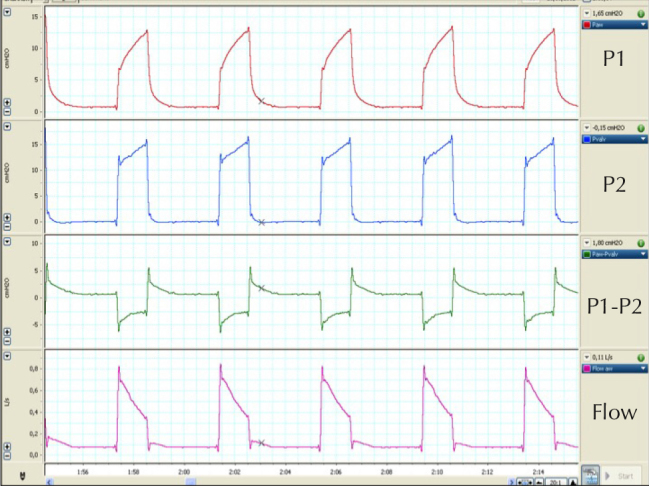
Difficulties in monitoring tidal volume with active valve. P1 reflects pressure inside the tubing. P2 corresponds to the pressure inside the pneumatic valve. P1–P2 corresponds to the difference (note than during inspiration, P2>P1, occluding the valve, and conversely during expiration, P1>P2, leading to valve opening). Finally, flow corresponds to the pneumotachograph signal placed between the ventilator and the valve (note that there is not expiratory flow signal). If non-intentional leakage occurs, it is very difficult to estimate the true tidal volume
Nowadays, because of its simplicity not only for the patient but also for caregivers, the most preferred configuration in home NIV is the single-limb with expiratory leak port, either in the whole mask or built as an independent piece between the mask and the tubing. Figure 2 (a, b) schematically represents the flow dynamics during inspiration and expiration when this type of circuit is used. The expiratory leak port acts as a continuous and intentional leakage (intentional F2 in Figure 2a), with a higher resistance (R2) than that imposed by the diameter of the tubing (R1).
Figure 2. a, b.
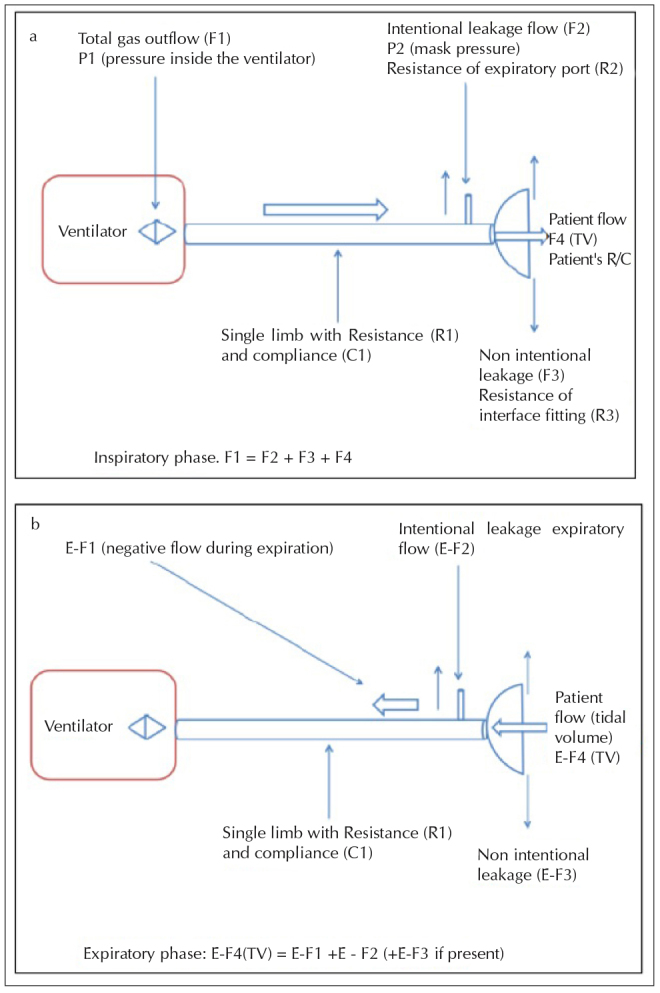
(a) Simplified model of flow/pressure dynamics during inspiratory phase in non-invasive ventilation with single circuit and intentional leakage (see text for more details). (b) Simplified model of flow/pressure dynamics during expiratory phase in non-invasive ventilation with single circuit and intentional leakage (see text for more details)
Following Figure 2a, during inspiration:
Conversely, during expiration (Figure 2b), the expiratory positive airway pressure (EPAP) flow “washes” the circuit, and the pneumotachograph only detects a small amount of expired gas. In this case, the expiratory TV would be the sum of this small backward flow (F1) plus intentional/non-intentional leaks (if present). Then, in the first step, the influence of this intentional continuous leak should be determined unless the TV and leak estimation could be wrong. From a physic point of view, the intentional leakage is a function of the pressure difference in and out of the tubing, and can be determined following the simplified formula of the Poiseuille’s law:
Intentional leakage can be indirectly explored by so-called leak test. In this test, the ventilator automatically increases pressure levels with the distal end of the mask or tubing occluded. Thus, pneumotachograph inside the ventilator captures only the flow escaping through the expiratory port, determining the relationship between pressure and leaks. Finally, the data are plotted in a XY graph (Figure 3), and a second-degree equation can fit the amount of intentional leak for each level of pressure with reasonable accuracy. Figure 4 shows the fit for a leak test with a linear and second-degree equation. These values can be subtracted from the native graphs (F1) to obtain the true gas flow entering into and exiting from the patient (in absence of non-intentional leaks). Unfortunately, only a few models of ventilators are equipped with this test. In their estimation, many devices do not use any information about what kind of expiratory port is used. In some modern models, the clinician can introduce the type of interface (nasal, oronasal, etc.) in the ventilator’s menu. If we consider that the flow values of the expiratory ports between masks can present huge differences between the models, it would be easily understandable that there might be an important source of error in TV and leakage estimation.
Figure 3.
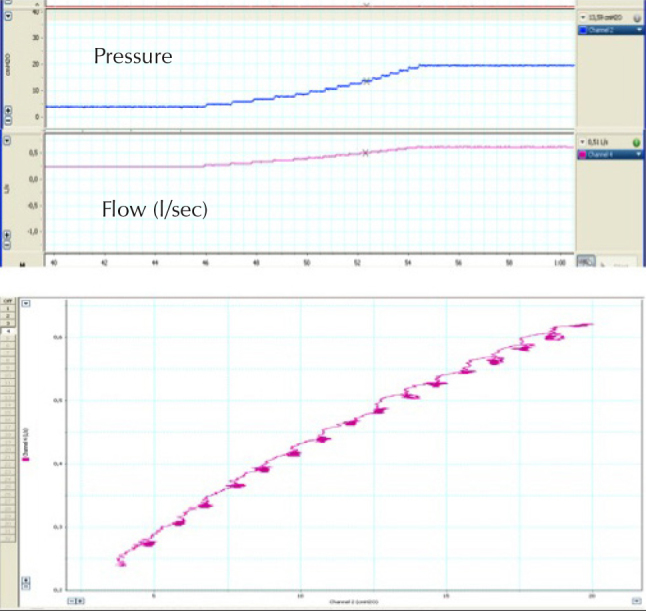
Leak test performed in the laboratory with an external pneumotachograph. In the upper panel, there is a progressive increase in pressure, with the corresponding increase in flow with the distal end of the tubing occluded and an expiratory port included in the circuit. In the lower panel, a pressure-leak plot is constructed
Figure 4.
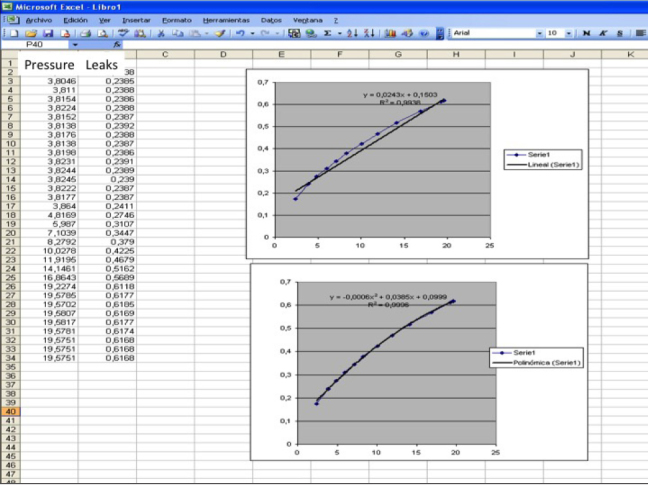
Plot in a Microsoft Excel sheet of the same data contained in Figure 4. Observe how the correlation degree in clearly better if a second-degree polynomial model (lower plot) is used instead of a first-degree (linear) model (upper plot)
At the same time, it should be taken into account that the conditions when the leak test is done (no TV, distal end occluded) are not the same as when the ventilator is used in the clinical practice (patient flow present). Following the same Poiseuille’s law, there is a loss of pressure across the tubing directly proportional to the ventilator’s outflow. P2 can be estimated by the following equation:(Figure 2a)
For this reason, some commercial ventilators are fitted with a proximal pressure sensor at P2 level. Other manufacturers developed a “pre-use test” to be performed before each clinical use. The purpose of such pre-use tests (do not confound with leak test) is to calculate the compliance (C1) and resistance (R1) of the circuit, to determine compressible volume and pressure loss respectively. Usually, C1 is measured with the completely closed distal end, and resistance is measured with the open distal end (in both cases without intentional leakage). The absence of such algorithms (or absence of direct P2 measurement) may lead to overestimation of P2 (and leaks) and underestimation of TV [3].
The second important problem during the development of algorithms to estimate leaks and TV are the presence of eventual non-intentional leaks around the mask. As displayed in Figure 2, in presence of continuous leaks, the pneumotachograph inside the ventilator “monitors” both TV and leakage. For each instant during the ventilator cycle, the relationship among total outflow, leakage, and patient flows (estimated) can be established by an equation as follows (intentional leakage was discarded here to simplify the concepts):
Here, F1 is total flow monitored inside the ventilator, and F4/F3 are patient flow and leakage flow. Considering that F1 is continuously monitored throughout the entire cycle, the problem is how to solve a system of a single equation with two unknowns. There are only two points in the cycle in which F4 (TV) value is known, for instance the transition points between inspiration and expiration. In these points, patient flow (F4) is 0 l/min, and the entire amount of flow monitored by the pneumotachograph inside the ventilator necessarily belongs to non-intentional leak (Figure 5). Manufacturers usually follow this principle, and estimate the leak value in the transition between expiration and inspiration, because the slope between inspiration and expiration is clearly steeper. Choosing a wrong measure point may lead to leakage over/underestimation.
Figure 5.
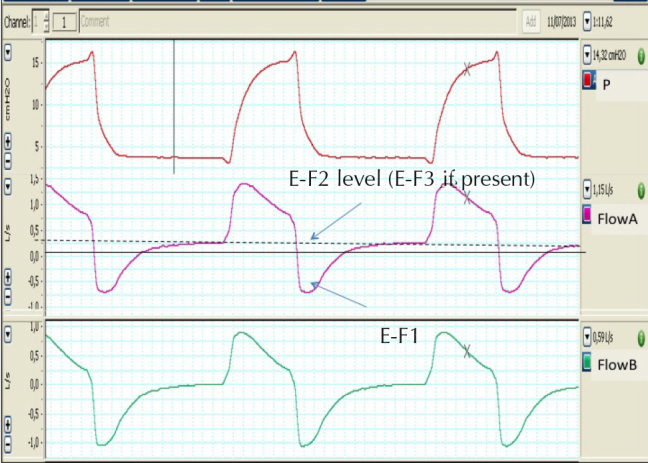
Flow measurements in single circuit with intentional leak. P=pressure. Flow A=flow directly measured on the ventilator’s exit (before intentional leakage). Flow B=flow at the entry of the patient (tidal volume). Note that in the Flow A signal, the baseline level (dashed line) is displaced upwards. E-F1 corresponds to the flow reaching the ventilator during expiration. E-F2 corresponds to baseline flow leakage during expiration
In fact, when applying this concept, they determine a resistance value (R3=EPAP/E-F3), and this value is usually applied throughout the entire cycle to estimate the amount of leaks for every instant in the flow-time curve.
This approach has two main drawbacks. First, the P2 value during expiration (EPAP) cannot reflect P1 during the entire expiratory phase. In other words, it is not necessarily constant. In fact, during expiration, there are changes in flow leading to small changes in the P2 value.
The second problem arises when this resistance value (R3) is not constant or is different during inspiration than during expiration. In clinical practice, it is not uncommon the finding of a non-intentional leak only during inspiration, or even at the end of inspiration without significant leakage during expiration (asymmetric leakage). In this case, the R3 values may show huge differences during a single cycle. This phenomenon can be simulated in a bench environment with the help of a unidirectional valve that generated leaks only during inspiration or expiration [4]. The results were that with inspiratory leaks, the commercial software overestimated TV, and vice versa with expiratory leaks. The results obtained in this study (overestimation of TV in a model of inspiratory leaks and underestimation in expiratory leaks) reinforced the hypothesis that the approach of considering unintentional leaks as a linear parameter can lead to significant misestimation of TV. In the same study, an algorithm based on the assumption of lack of proportionality between inspiratory and expiratory phases showed minimal deviations in the estimation of TV and unintentional leaks.
The identification of the wrong estimation of TV and leaks when inspiratory non-intentional leaks occur is also possible though the examination of flow-time waveform. If the area under inspiratory phase seems much greater than that in the expiratory phase, it suggests inspiratory leaks. Even more visual interpretation can be the assessment through volume-time waveform (unfortunately, few built-in software displays it), which in fact is the integral of flow waveform over time. If the inspiratory (positive) area is greater than the expiratory area (e.g., in presence of inspiratory leaks), the software must restart the volume-time waveform at the zero level. This restart is usually seen when flow-time waveform crosses the zero level, from negative to positive flow, and it is commonly seen as an abrupt “drop” in volume-time graph (Figure 6). From a clinical point of view, when the mentioned drop appears, the TV values in these cycles are unreliable.
Figure 6.
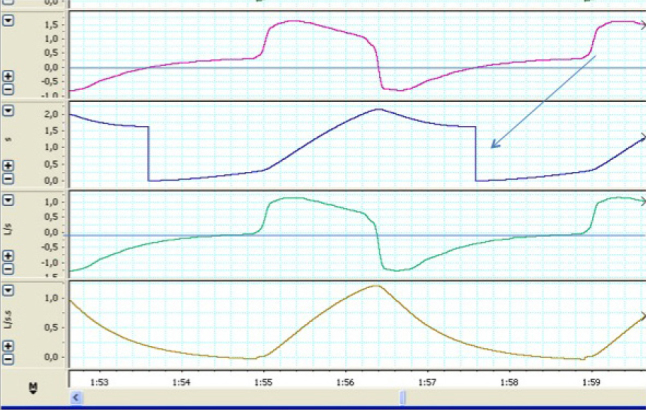
Differences in flow-time and volume-time waveform when monitoring before (upper part) and after the leaks (lower). Observe the drop in volume-time corresponding to restart of the waveform (see text for details)
Finally, a third source of variability is the presentation of leak information in the screen and in the built-in software. Whereas some manufacturers provide the information concerning leaks only as non-intentional values, others display global leaks, including values related to the expiratory port. This lack of standardization can be confusing for the clinician.
The drawbacks of this misestimation can go beyond wrong information to the clinician. It should be highlighted that in some new modes of NIV (the dual control or volume-targeted pressure support modes), the ventilator takes its own decisions based on target TV estimation. As demonstrated in a recent study [5], if asymmetric leaks appear, the ventilator can modify its pressure support level in a different way than expected. In this setting, it seems reasonable to recommend setting in the ventilator a safety lower level of pressure support.
TV and Leak Estimation in Bench Studies
There is a growing evidence that bench testing is an important and relevant component to assess the performance of NIV devices, although they have some limitations such as the models usually lack reflecting complex variations that occur during real life, such as inspiratory effort, respiratory drive, ventilatory pattern, and variability of unintentional leaks. However, a few studies addressed the accuracy of the information provided by device software.
Contal et al. [1] analyzed seven home NIV devices for leak quantification and estimation of TV with and without unintentional leaks. Each ventilator was tested for variable degrees of leak (0–10–24–40 and 60 L/min) at 15 and 25 cm H2O of inspiratory pressure and 5 cm H2O expiratory airway pressure. Recordings were performed with normal respiratory mechanics model. When compared, it was observed that the estimation of leaks by different software varied significantly between ventilators. The assessment of leaks was highly reliable. It correlated well for the three ventilators, and bias was very close to zero. In contrast to that finding, the other four ventilators underestimated the magnitude of leaks by 6–26 L/min. One device estimated leaks only during the expiratory phase. Bias for the estimation of leaks increased with the magnitude of unintentional leaks. Increasing leaks also generated auto triggering in two ventilators. TV was underestimated by all NIV devices, ranging between 66 and 236 mL. The difference increased with higher IPAP level (25 cm H2O) and between 89 and 328 mL without unintentional leaks, and 97 and 404 mL with an unintentional leak of 60 L/min. In our opinion, these differences simply suggest that manufacturers are using different algorithms to estimate TV and leaks.
A possible explanation for underestimation of TV is lack of compensation for pressure loss within the tubing system. Luján et al. [3] evaluated the TV estimation of five NIV devices by comparing TV values calculated by built-in-software with TV measured by a calibrated pneumotachograph under increasing levels of the controlled leak. The main aim of the study was to determine whether an incorporation of a mathematical algorithm that computes leak-related pressure losses between the proximal and distal side of the single tubing might improve the reliability of TV estimation of built-in software of the devices. The ventilators tested for calibrated leak flows (35, 45, 55, 65 L/min) on 20 cm H2O of continuous positive airway pressure (CPAP) that corresponds to estimated leak flows for the interfaces that are often used in clinical practice. In addition, each leak level was tested for three different respiratory conditions (normal, obstructive, and restrictive) with three different levels of inspiratory pressure (5, 10, 15 cm H2O). The first important finding of this study was significant differences shown between displayed and externally measured TV in absolute values by all ventilators, and all of them underestimated TV, ranging between 22±9 mL and 84±25 mL. In the presence of the lowest leak (35 L/min on CPAP of 20 cm H2O), which corresponds to the values for a nasal mask, ventilators displayed TV in totally different values. The second important finding was a linear relationship observed between the magnitude of leak and volume underestimation in all ventilators. The underestimation reached values near 20% of the externally measured TV in the presence of high leaks in some ventilators. In three ventilators, underestimation of TV was more pronounced when the breathing pattern was obstructive. The authors reported that incorporating a mathematical algorithm to the software for pressure loss through the tubing improved the accuracy of TV measurements.
One characteristic of unintentional leaks is that they are dynamic, which means they can change during the inspiratory or expiratory phase of the respiratory cycle. Theoretically, the presence of dynamic (asymmetric) leaks is a challenge for the NIV software systems to compensate unintentional leaks. Two bench studies assessed the estimation of TV and unintentional leaks during the asymmetric leak model. In the first study [4], the reliability of TV estimation was tested in a single tube bench model with random dynamic leaks (high and low level) during two levels of pressure support (10 cm H2O and 15 cm H2O). In the basal condition with only intentional leaks, which corresponds to standard nasal mask leak, all four ventilators except for one underestimated TV. In the model of inspiratory unintentional leaks, TV was overestimated ranging between 137 mL and 264 mL. Two ventilator softwares underestimated leaks ranging between −11.5 and −6 L/min. In the model of expiratory leaks, high level of unintentional leaks caused auto-triggering in all ventilators. For that reason, the performance of ventilators only assessed during the low expiratory leak. In that case, three ventilators underestimated TV (ranging between −48 and −29 mL), and one ventilator overestimated it. All ventilators overestimated unintentional leaks ranging from 2.2 to 3.1 L/min. These results show that the estimation of TV in the presence of asymmetric leaks is erroneous, either underestimated or overestimated depending on the phase of the respiratory cycle.
In the second study, the same investigator group [5] studied the effect of these asymmetric leaks occurring either inspiration or expiration in volume-guaranteed ventilation with single-limb circuit. To simulate asymmetric unintentional leaks, a T-piece was inserted after a commercial leak port that corresponds to the continuous intentional leak used in clinical practice. In the inspiratory leak model, a 7.5 cm H2O PEEP threshold valve was attached. Two levels of unintentional leaks (low and high) were introduced into the system with calibrated holes. The study showed the addition of inspiratory leak resulted in a progressive decrease both in pressure support and the delivered TV, falling below the targeted value. Clinically, it was shown that the mean delivered TV could drop by 40% in the presence of excessive inspiratory leaks. The delivered TV was significantly different between low and high inspiratory leak levels in all ventilators, except one. During expiratory leak model, an active valve was used, and attached to the T-piece. It was observed that the presence of expiratory leaks caused an increase in both pressure support and delivered TV. The increase in TV differed between ventilators ranging between 16% and 33%.
Carlucci et al. [6] addressed the importance of configuration of tubing in leak and TV estimations during volume-guaranteed ventilation, and showed that the ability of ventilators to compensate for unintentional leaks directly depends on the configuration of the circuit used. In the bench, they have assessed three home devices with single-limb circuits either with an intentional leak or with an expiratory valve. The model consisted of three levels of leak (15, 25, and 37 mL/min) during normal, obstructive, and restrictive respiratory pattern. In the absence of leaks, all ventilators, irrespective of selected configuration, were able to maintain TV in all respiratory conditions. In the presence of intentional leaks, all ventilators achieved to guarantee TV by increasing inspiratory pressure. However, all ventilators failed to maintain minimal TV by dropping the inspiratory pressure during unintentional leaks when a single circuit used with an expiratory valve.
Similar to that, Khirani et al. [7] studied seven home ventilators with different circuit configurations. It was observed that among five ventilators that can be used with single-limb and intentional leak, only two maintained TV at its target in the presence of unintentional leaks. In two ventilators used with a single-limb circuit and an expiratory valve, TV fell below the preset value. In three ventilators that can be used with a double-limb circuit, only one of the ventilators overcompensated TV during unintentional leaks, and TV was decreased in the other two ventilators. The authors concluded that volume-guaranteed mode is effective only when a single-limb circuit with an intentional leak (leak port circuit) was used. Ventilators using a circuit configuration of double-limb circuit or a single-limb circuit with an expiratory valve may misinterpret unintentional leaks as an increase in TV, and paradoxically decrease inspiratory pressure and therefore TV.
The automatic increase in inspiratory pressure during volume-guaranteed mode in the presence of unintentional leaks is associated with large variations in TV [8]. Six NIV devices were evaluated for the delivery of a minimal TV in three conditions associated with alveolar hypoventilation: increase in airway resistance, decrease in lung compliance, and unintentional leaks. The authors defined “volume guarantee failure” as the inability to maintain TV of more than 500 mL and “overshooting” as a TV>650 mL. In the model of increased airway resistance, five ventilators were able to maintain a minimal TV of 500 mL. Of them, one ventilator overshot TV. In the model of decrease in lung compliance, five ventilators were able to maintain a minimal TV, and no overshooting was observed. However, the maintenance of a minimal TV during unintentional leak was not that sufficient. Only one ventilator was able to guarantee minimal TV with overshooting, and patient ventilator asynchrony was observed with all other devices.
IMPLICATIONS IN CLINICAL PRACTICE
The main goals of the NIV therapy are to maintain sufficient alveolar ventilation, improve pulmonary gas exchange, assist respiratory muscles, and decrease work of breathing. The ability of an NIV device to maintain a stable TV is related not only to its pressurization capacity but also to its accurate assessment of leaks and TV. Ideally, a ventilator should be able to rapidly respond to changes for effective TV with and without leaks and, changes in respiratory system impedance. Insufficient support because of inaccurate measurement of leaks and therefore TV inevitably would cause ineffective assisted ventilation and, therefore, persistent hypercapnia.
Recently, built-in software has been available for clinicians to monitor and download data in the NIV devices. The NIV settings are usually adjusted according to the parameters shown by the ventilator software. Clinicians should keep in mind that each NIV device is different, and the reliability and the accuracy of leak and TV estimation are highly variable from one device to another. Underestimation or overestimation of leaks and TV by the software can cause wrong adjustments. Moreover, because of underestimation of TV, clinicians usually tend to increase inspiratory pressures to maintain adequate ventilation. This would eventually increase the possibility of unintentional leaks and/or hyperinflation. If there is a marked increase in the inspiratory flow during compensation, several other side effects such as increased leakage, impaired mask seal, eye irritation, and increased aerophagia and gastric distention may occur. The consequences of these problems result in patient discomfort and non-compliance to NIV. This might be particularly more problematic in volume-targeted modes as these modes change IPAP depending on estimated TV. The presence of unintentional asymmetric leaks could lead to clinically significant hypoventilation because of a decrease in inspiratory pressure. An overshooting of TV during volume-targeted ventilation may cause hyperventilation, patient ventilator asynchrony, decrease in patient’s respiratory effort, and arterial carbon dioxide levels lower than the apnea threshold [8,9].
Bench studies showed that the underestimation of TV is directly related to the magnitude of leaks [3]. The degree of intentional leak is dependent not only on the pressure but also on the interface used. The mask determines the level of intentional leak, but estimation of this leak and therefore variations in inspiratory time and TV is determined by the ventilator [10]. Many manufacturers validate the performance of their NIV device only with their own mask. Hence, each built-in software would erroneously estimate leaks and TV in the presence of a different mask/interface. Even in the condition of perfect fitting, the magnitude of intentional leaks can change up to 20%–25% between different masks. Borel et al. [11] showed that the capacity of ventilators to achieve and maintain preset IPAP is directly related to mask intentional leaks that were highly variable ranging between 30 and 45 L/min. Increasing intentional leaks (>40 L/min) because of a mask significantly impaired the capacity of all ventilators to attain and maintain a preset IPAP. Moreover, the amount of leaks from mask may produce patient ventilator synchrony. It was also shown that mask with larger air leaks was shown to be associated with auto-triggering and/or decreased inspiratory-trigger sensitivity [10]. Underestimation of leak flow would delay expiratory trigger time and therefore increase inspiratory time and TV; whereas overestimation of leak would shorten it and decrease both parameters. Another important technical point to consider is the circuit configuration. So, far, studies showed that the best option for NIV configuration for compensation of unintentional leaks and accurate estimation of TV is single-limb circuit with an intentional leak [6,7]. In the presence of a true expiratory valve, most NIV devices fail to perform efficiently.
Today, many centers use telemonitoring for the management of NIV support. With new developments in technology, remote adjustment of ventilatory settings by the clinician according to electronically transferred data from the patient’s device can be an option [12–14]. Although electronically transferred data from built-in software may provide important information in a very feasible way, clinicians should be very cautious for the heterogeneity and inaccuracy of parameters from online downloaded data provided by the different software systems of NIV devices. The lack of validation of these software and monitored parameters by independent authorities is one of the main limiting factors of its wider use.
CONCLUSION
Non-invasive ventilation is accepted as an effective therapy for acute and chronic respiratory failure. The success of NIV is directly related to monitoring therapy optimally. Today’s technology gives us the opportunity to monitor, even remotely, many parameters by built-in software systems of NIV devices. However, the results from bench studies showed that the accuracy and reliability of the information provided by the software systems are still questionable, and external validation of these systems is an urgent need. For now, we should keep in mind that data from NIV software are helpful, but they should only be used in conjunction to other monitoring parameters such as the clinical status of the patient, pulse oximetry, arterial blood gas analysis, and polysomnography when needed. Finally, medical societies should ask the manufacturers for homogeneity in their algorithms estimating physiological parameters in the ventilated patient.
Footnotes
Peer-review: Externally peer-reviewed.
Author Contributions: Concept – M.L. ;Design – M.L.; Supervision – M.L., B.E.; Resources – M.L., C.L., B.E.; Materials – M.L., C.L., B.E.; Data Collection and/or Processing – M.L., C.L., B.E.; Analysis and/or Interpretation – M.L., C.L., B.E.; Literature Search – M.L., C.L., B.E.; Writing Manuscript – M.L., C.L., B.E.; Critical Review – M.L., C.L., B.E.; Other – M.L., C.L., B.E.
Conflict of Interest: The authors have no conflicts of interest to declare.
Financial Support: Cristina Lalmolda has a research grant to recruit professional staff in NIV investigation (Pla estratègic de recerca i innovació en salut (PERIS) 2016–2020, Generalitat de Catalunya, Barcelona, Spain).
REFERENCES
- 1.Contal O, Vignaux L, Combescure C, et al. Monitoring of noninvasive ventilation by built-in software of home bilevel ventilators. Chest. 2012;141:469–76. doi: 10.1378/chest.11-0485. [DOI] [PubMed] [Google Scholar]
- 2.Masselli GM, Silvestri S, Sciuto SA, et al. Circuit compliance compensation in lung protective ventilation. Conf Proc IEEE Eng Med Biol Soc. 2006;1:5603–6. doi: 10.1109/IEMBS.2006.260066. [DOI] [PubMed] [Google Scholar]
- 3.Luján M, Sogo A, Pomares X, et al. Effect of leak and breathing pattern on the accuracy of tidal volume estimation. Respir Care. 2013;58:770–7. doi: 10.4187/respcare.02010. [DOI] [PubMed] [Google Scholar]
- 4.Sogo A, Montanyà J, Monsó E, et al. Effect of dynamic random leaks on the monitoring accuracy of home mechanical ventilators: a bench study. BMC Pulm Med. 2013;13:75. doi: 10.1186/1471-2466-13-75. [DOI] [PMC free article] [PubMed] [Google Scholar]
- 5.Luján M, Sogo A, Grimau C, et al. Influence of dynamic leaks in volume-targeted pressure support noninvasive ventilation: a bench study. Respir Care. 2015;60:191–200. doi: 10.4187/respcare.03413. [DOI] [PubMed] [Google Scholar]
- 6.Carlucci A, Schreiber A, Mattei A, et al. The configuration of bi-level ventilator circuits may affect compensation for non-intentional leaks during volume-targeted ventilation. Intensive Care Med. 2013;39:59–65. doi: 10.1007/s00134-012-2696-8. [DOI] [PubMed] [Google Scholar]
- 7.Khirani S, Louis B, Lreoux K, et al. Harms of unintentional leaks during volume targeted pressure support ventilation. Respir Med. 2013;107:1021–9. doi: 10.1016/j.rmed.2013.03.013. [DOI] [PubMed] [Google Scholar]
- 8.Fauroux B, Leroux K, Pepin JL, et al. Are home ventilators able to guarantee a minimal tidal volume? Intensive Care Med. 2010;36:1008–14. doi: 10.1007/s00134-010-1785-9. [DOI] [PubMed] [Google Scholar]
- 9.Storre JH, Bohm P, Dreher M, et al. Clinical impact of leak compensation during non-invasive ventilation. Respir Med. 2009;103:1477–83. doi: 10.1016/j.rmed.2009.04.020. [DOI] [PubMed] [Google Scholar]
- 10.Loius B, Leroux K, Isabey D, et al. Effect of manufacturer-inserted mask leaks on ventilator performance. Eur Respir J. 2010;35:627–36. doi: 10.1183/09031936.00188708. [DOI] [PubMed] [Google Scholar]
- 11.Borel JC, Sabil A, Janssens JP, et al. Intentional leaks in industrial masks have a significant impact on efficacy of bilevel noninvasive ventilation: a bench test study. Chest. 2009;135:669–77. doi: 10.1378/chest.08-1340. [DOI] [PubMed] [Google Scholar]
- 12.Janssens JP, Borel JC, Pèpin JL SomnoNIV Group. Nocturnal monitoring of home non-invasive ventilation: the contribution of simple tools such as pulse oximetry, capnography, built-in software and autonomic markers of sleep fragmentation. Thorax. 2011;66:438–45. doi: 10.1136/thx.2010.139782. [DOI] [PubMed] [Google Scholar]
- 13.Mansell SK, Cutts S, Hackney I, et al. Using domiciliary non-invasive ventilator data downloads to inform clinical decision-making to optimise ventilation delivery and patient complicance. BMJ OPen Respir Res. 2018;5:e000238. doi: 10.1136/bmjresp-2017-000238. [DOI] [PMC free article] [PubMed] [Google Scholar]
- 14.Rabec C, Georges M, Kabeya NK, et al. Evaluating noninvasive ventilation using a monitoring system coupled to a ventilator: a bench to bedside study. Eur Respir J. 2009;34:902–13. doi: 10.1183/09031936.00170508. [DOI] [PubMed] [Google Scholar]


